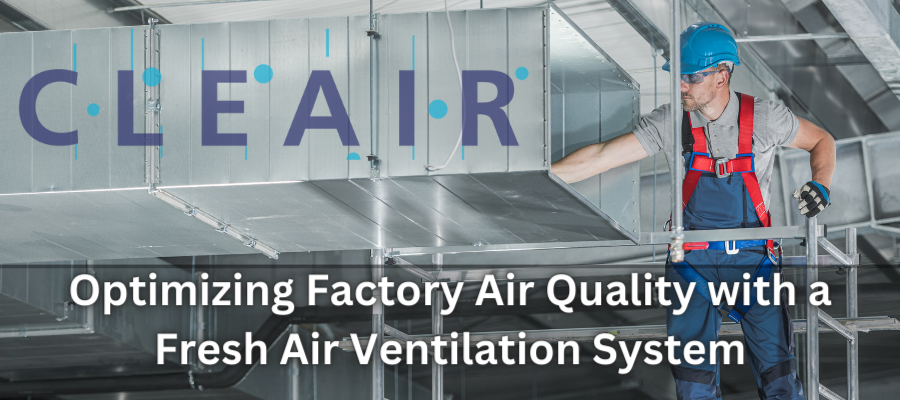
Optimizing Factory Air Quality with a Fresh Air Ventilation System
The need for fresh and clean air within factories is critical in today’s industrial landscape. A fresh air ventilation system for a factory is not only a legal requirement, but also a critical component of creating a safe and productive working environment. In this article, we’ll look at the importance of fresh air ventilation systems in factories, their benefits, and key considerations for effectively implementing them.
Why Fresh Air Ventilation Matters for Factories
Pollutants such as dust, fumes, and other harmful contaminants are common in factory environments. These pollutants can accumulate without proper ventilation, causing a variety of issues such as decreased employee productivity, health issues, and increased equipment maintenance costs. Fresh air ventilation systems, which constantly circulate clean, outdoor air into the factory space, play a critical role in mitigating these challenges.
Key Benefits of Fresh Air Ventilation Systems
Fresh air ventilation systems offer several key advantages to factories that prioritize air quality and the well-being of their employees. Let’s explore these benefits in more detail:
- Improved Air Quality: Fresh air ventilation systems continuously introduce outside air, lowering the concentration of pollutants indoors. As a result, your factory workers will breathe cleaner, healthier air. Improved air quality helps to prevent respiratory issues and allergies, making the workplace more comfortable.
- Enhanced Employee Productivity: Cleaner air improves employee well-being and, as a result, productivity. Workers feel more alert and focused with a steady supply of fresh air, which can lead to increased efficiency and reduced absenteeism. A more productive workforce is one that is healthier.
- Energy Efficiency: Modern ventilation systems are built to be energy efficient. They incorporate energy-saving features such as heat recovery and variable-speed fans. By reducing operational costs, you not only save money but also reduce the carbon footprint of your factory.
- Compliance with Regulations: Many regions have stringent regulations regarding industrial indoor air quality. Installing a fresh air ventilation system ensures that these standards are met. This not only avoids potential fines, but also demonstrates your dedication to creating a safe working environment.
- Equipment Longevity: Airborne dust and pollutants can cause equipment wear and tear. A ventilation system that filters out these contaminants can help your machinery last longer, lowering maintenance and replacement costs.
- Odor Control: Manufacturing processes frequently produce a variety of odours in factories. Fresh air ventilation systems aid in the control and dissipation of odours, making the workplace more pleasant for both employees and visitors.
Factors to Consider when Choosing a Fresh Air Ventilation System
- Air Exchange Rate: Ensure that the system provides an adequate number of air changes per hour to maintain air quality.
- Filtration Efficiency: Look for systems with high-efficiency filters to trap contaminants effectively.
- Climate Control: Opt for systems that can also control temperature and humidity for comfort and process requirements.
- Size and Capacity: Choose a system that matches the size and needs of your factory space.
- Maintenance and Service: Regular maintenance is essential to keep the system running optimally.
Implementing a Factory Air Quality Improvement
Enhancing air quality within a factory environment is a critical aspect of ensuring a healthy and productive workspace. Here’s a brief overview of the key steps involved in implementing a factory air quality improvement plan:
- Assessment: Begin by assessing the current air quality in your factory. Identify the sources of pollution, such as dust, fumes, or chemical emissions. This assessment serves as the foundation for your improvement strategy.
- Identify Priority Areas: Once you’ve identified the sources of pollution, prioritize the areas that need immediate attention. Consider factors like employee workstations, machinery locations, and high-traffic zones.
- Select Appropriate Solutions: Choose the right solutions to address the specific air quality issues in your factory. This may include the installation of fresh air ventilation systems, air purifiers, or local exhaust systems, depending on the nature of the pollutants.
- Professional Installation: Proper installation of air quality improvement systems is crucial. Ensure that experienced professionals handle the installation to guarantee optimal performance.
- Employee Training: Educate your employees about the importance of air quality and how the newly implemented systems work. Encourage them to report any issues promptly.
- Regular Maintenance: Create a maintenance schedule to ensure that the systems continue to operate effectively. Routine filter changes and system inspections are essential for long-term success.
- Monitoring and Adjustments: Implement air quality monitoring systems to track changes and make adjustments as needed. This data can help you fine-tune your air quality improvement strategy over time.
- Documentation and Compliance: Keep records of maintenance, assessments, and any changes made to your air quality improvement plan. This documentation can be crucial for compliance with regulations and for demonstrating your commitment to a safe working environment.
Conclusion
A fresh air ventilation system for your factory is not just an investment in compliance but also in the well-being of your employees and the long-term success of your business. By ensuring a continuous supply of clean, fresh air, you can create a safer and more productive working environment. Remember to consider the factors mentioned above when selecting a system, and explore the benefits of enhanced air quality in your industrial facility. Implementing the right fresh air ventilation system is a step toward ensuring your factory’s success and well-being.


